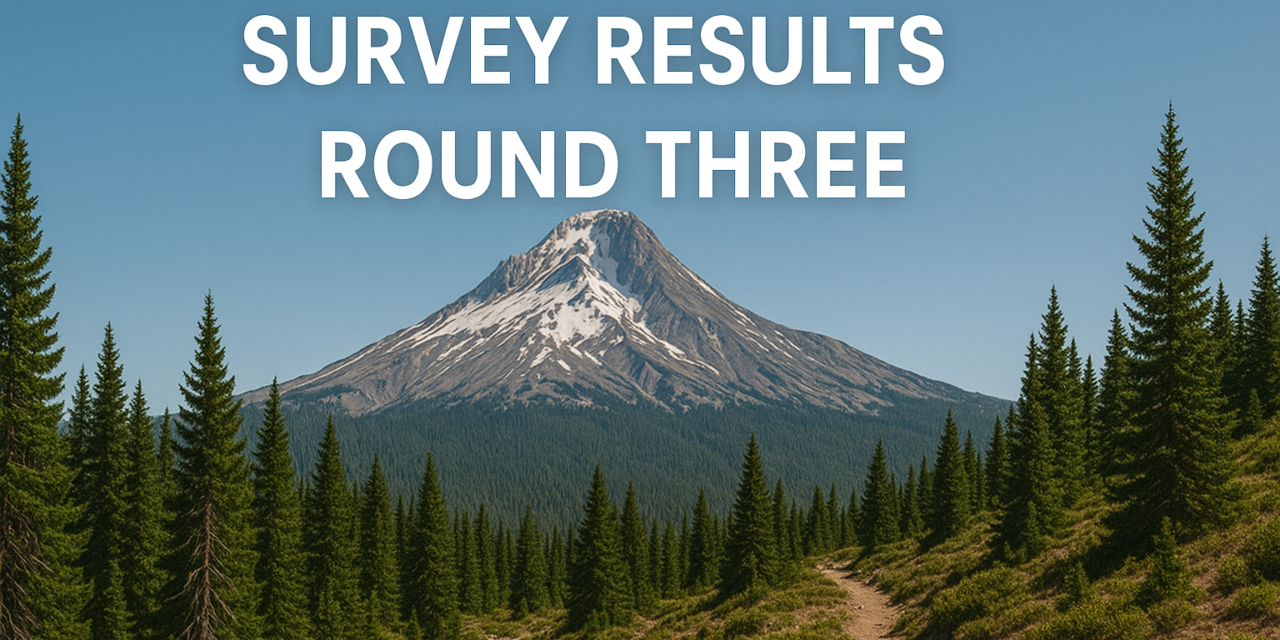This is the final analysis of data from the 2024 Timberline Trail survey results. With 148 responses, this year’s survey provides valuable insights into how hikers experienced this iconic 40+ mile loop around Mount Hood, and how trends have evolved since our 2023 survey.
Let’s dive into the final set of data results from the 2024 Timberline Trail survey!
Did you complete your hike as planned?
2024 Results: 92% completed as planned, 8% did not.
The completion rate remained remarkably consistent year-over-year, with a slight 1% increase in hikers experiencing unplanned changes to their itinerary. This suggests that despite better information availability and trail conditions, the Timberline Trail continues to present consistent challenges that affect roughly 1 in 12 hikers.
Early Trail Departures
2024 Results: 14% left the trail earlier than planned, 86% completed their full planned route.
The early departure rate improved slightly from 2023, dropping by 1 percentage point. This small but positive trend suggests hikers may be getting better at planning appropriate itineraries for their skill level, or trail conditions were more favorable in 2024.
With multiple exit points around Mount Hood, hikers have options when conditions change. However, some northern trailheads like Vista Ridge and Elk Cove remain quite remote, making early exits logistically challenging.
Emergency Services and SAR Calls
2024 Results: Only 2% (3 hikers) needed to call emergency services or SAR.
While there was a slight increase in emergency calls, the numbers remain very low. It’s worth emphasizing that on Mount Hood, there is no charge for SAR callouts, and calling for help early is always preferable to creating a more dangerous situation.
Health and Injury Issues
The 2024 survey revealed some interesting patterns in hiker health issues:
Most Common Issues (Mild to Moderate):
- Blisters: 44% experienced some level of blister issues (33% mild, 7% moderate, 4% major)
- Foot Pain: 48% had foot pain issues (33% mild, 11% moderate, 4% major)
- Knee Pain: 34% experienced knee problems (22% mild, 9% moderate, 3% major)
- Mosquitoes: 36% found mosquitoes problematic (27% mild, 8% moderate, 1% major)
Comparison to 2023: There was a general increase in reported mild issues, particularly with blisters and foot pain. This could indicate hikers are pushing themselves harder or that trail conditions were more challenging in 2024.
Other reported issues included:
- Altitude adjustment challenges
- Equipment failures
- Weather-related discomfort
- Navigation difficulties in some sections
Fortunately, major injuries remained rare, with only 1% reporting serious incidents like broken bones.
Camping Etiquette and Leave No Trace Practices
The 2024 results show encouraging improvements in Leave No Trace practices:
Water Treatment: 94% filter water most or all of the time (79% all the time, 15% most of the time)
Camping Practices:
- Durable Surfaces: 96% camp on durable surfaces most/all of the time
- 100 feet from water: 90% maintain proper distance from water sources most/all of the time
- Waste Disposal: 95% bury waste at least 6″ deep most/all of the time
Hand Washing: This remains the most inconsistent practice, with only 45% washing hands before eating most or all of the time.
Comparison to 2023: Overall improvement in all Leave No Trace practices, suggesting better education and awareness among the hiking community.
Toilet Paper Disposal
2024 Results:
- 45% bury their toilet paper
- 44% pack it out
- 11% use a backcountry bidet
2023 Comparison: Pack-out rates dropped slightly from 49% in 2023 to 44% in 2024, while burial increased. The use of backcountry bidets increased from 9% to 11%.
This represents a slight reversal from the positive 2023 trend toward packing out TP, though pack-out and burial remain nearly equal. The continued growth in bidet usage is encouraging for minimizing waste issues.
Campsite Availability
2024 Results:
- 77% never had problems finding campsites
- 23% sometimes had problems
- 0% often had problems
Campsite availability actually improved in 2024, with fewer hikers reporting frequent problems and a higher percentage never encountering issues. This could indicate better dispersal of hikers throughout the season or improved campsite information availability.
Demographics
Hiker Age Distribution
Summary Statistics
- Total responses with age data: 140 out of 148 submissions (94.6% response rate)
- Age range: 18 to 70 years old
- Average age: 42.4 years
- Median age: 42 years
Key Insights
- Peak hiking age: The 30s represent the largest group, suggesting this is when people have the combination of physical capability, experience, and possibly time/resources for multi-day backpacking
- Strong middle-age participation: Combined 40s and 50s make up 42.9% of hikers, showing that challenging backpacking remains popular well into middle age
- Notable older hikers: 13 hikers were 60 or older (9.3%), including one 70-year-old, demonstrating that age doesn’t necessarily limit participation in demanding outdoor activities
- Adult-focused activity: Very few hikers in their late teens/early 20s, suggesting this particular trail requires significant experience, planning, or resources typically acquired later in life
Hiker Age Distribution
Distribution of 140 hikers by age decade (8 responses missing age data)
Gender Distribution:
- Male: 57%
- Female: 41%
- Non-binary/Non-conforming: 2%
This represents a shift back toward more male participants compared to 2023’s female majority.
Race/Ethnicity:
- White: 93%
- Hispanic: 2%
- Asian: 2%
- Multiracial: 2%
- Black/African American: 1%
The trail continues to attract a predominantly white hiking population, with slight increases in diversity compared to previous years.
Experience Level:
- First-time Timberline hikers: 68%
- Previous completions: 32% (ranging from 1 to 4+ previous hikes)
The majority of hikers were experiencing the Timberline Trail for the first time, indicating the trail’s growing reputation and appeal.
2024 vs 2023 Key Comparisons
Positive Trends:
- Improved campsite availability
- Better Leave No Trace practices overall
- Consistent completion rates
- Strong equipment preparation (94% using trekking poles)
Areas for Attention:
- Slight increase in health issues
- Small uptick in emergency service calls
- Regression in toilet paper pack-out rates
- Hand hygiene remains inconsistent
Stability Indicators:
- Starting location preferences unchanged
- Trail completion rates consistent
- Gender distribution variations within normal ranges
Notable 2024 Comments
Trail Navigation & Route Finding
- Newtown Creek area: “Be cautious when coming up to Newtown Creek CCW. We had a hard time finding the correct path down due to multiple other foot trails. Saw other people struggle with this too”
- Signage needs: “Wish there was more signage” and “White River crossing points could be more clearly marked”
- Technology limitations: “Don’t rely on AllTrails map download. I downloaded it but didn’t work without having connection and I took few wrong turns and walked extra 8 miles”
Water Crossings & Safety
- Elliot Crossing improvements: “Elliot Crossing was VASTLY better than last year (thanks maintainers)” and “Loved the rope at eliot, VERY helpful”
- Safety concern: “Note: there is a rope being used to climb in/out of the ravine @ Elliot. After we got to the top, we noticed it was dangerously fraying and about to snap. We opted to cut the rope so that an unsuspecting hiker wouldn’t rely on it”
- Timing matters: “Great trail, early morning river crossings are the easiest”
- Seasonal conditions: “You might want to add an option about crossing creeks on snow bridges, not just logs or wade. Because of an avalanche there has been a snow bridge on Clark Creek all season”
Challenging Sections
- Ramona Falls to Cloud Cap: “The span between Ramona Falls and Cloud Cap felt significantly longer, in both miles and hours of hiking, than expected… through that section I felt incredibly slow despite my usual hiking abilities”
- Final approach: “The last 2-4 miles of the hike CW towards timberline lodge were also more difficult from the terrain so I’d recommend taking a break before starting the sandy section”
Environmental Concerns
- Leave No Trace issues: “The area directly behind my campsite at Elk Cove was covered in toilet paper, wipes and even a dehydrated meal bag” and “Unfortunate to see poor human waste management around most camps, visible TP coming out from under rocks”
- Trail maintenance: One hiker noted picking up “2.5 oz of trash along the route. Mostly little easily/accidentally dropped things”
Practical Tips
- Water strategy: “There was so much water everywhere else, and water is heavy!” and “Would carry 1.5 liters of water and refill often”
- Footwear: “Use crocs or lightweight water shoes for water crossings” and “Slipped into strapped sandals for wading”
- Equipment: “Poles are a must” and “Pack light. The trail has a lot of steep elevation changes”
Standout Experiences
Overall sentiment: “Best backpacking trip of my life!!” and “Absolutely amazing! Only thing I would do differently is take more days so I could take my time”
Best campsite: “Best campsite along the trail is the cowboy ledge above McNeil point!”
Wildflowers: “All the wildflowers in mid August are amazing”
Looking Forward
The 2024 Timberline Trail survey results paint a picture of a trail that continues to challenge and reward hikers while maintaining consistent patterns of use and experience. The slight increases in health issues may warrant attention to preparation and conditioning advice, while the improvements in campsite availability and Leave No Trace practices are encouraging trends.
As the trail’s popularity continues to grow, maintaining the balance between accessibility and preservation will be crucial. The high percentage of first-time hikers underscores the importance of good information resources and preparation guidance.
Thank you to all 148 hikers who participated in the 2024 survey! Your responses help create a valuable resource for future Timberline Trail adventurers and contribute to our understanding of how this iconic trail is being used and experienced. And that completes the Timberline Trail Results 2024 – Final Analysis.
Timberline Trail Results 2024 – Part 1
Timberline Trail Results 2024 – Part 2


